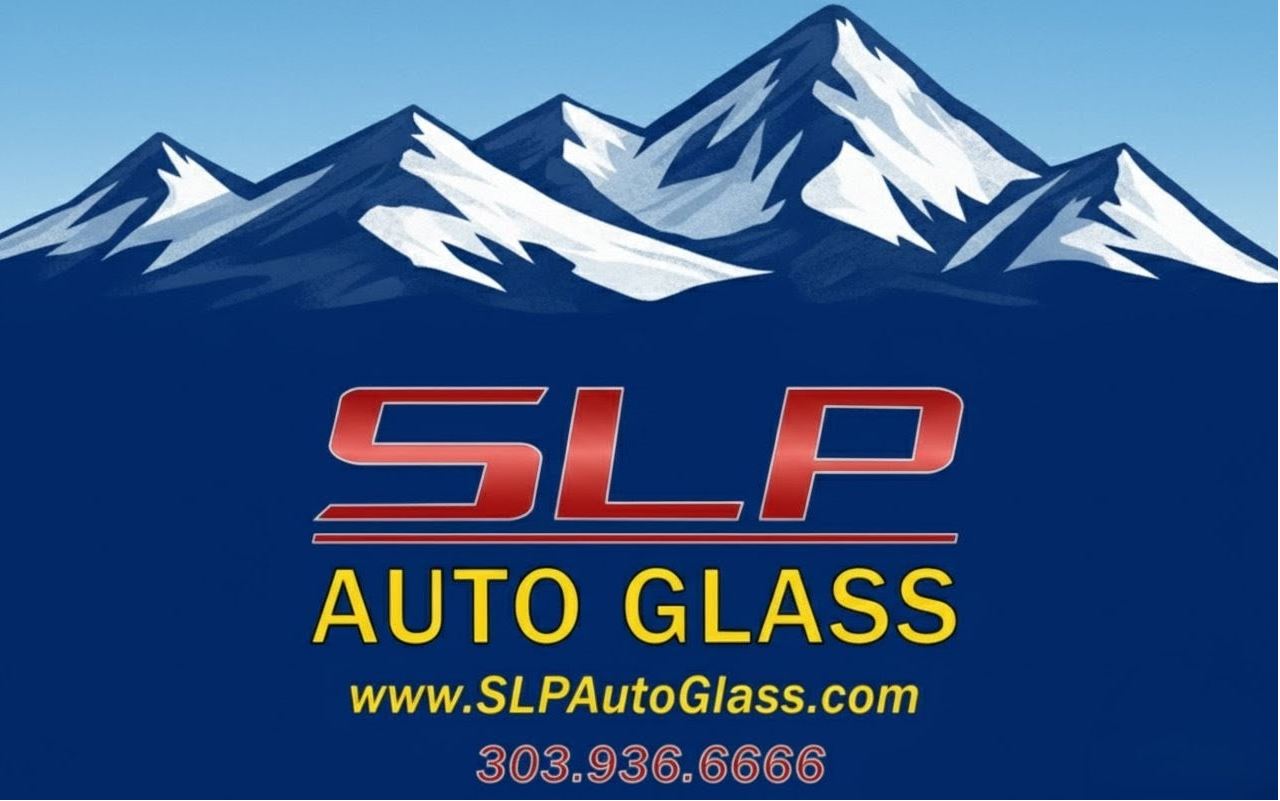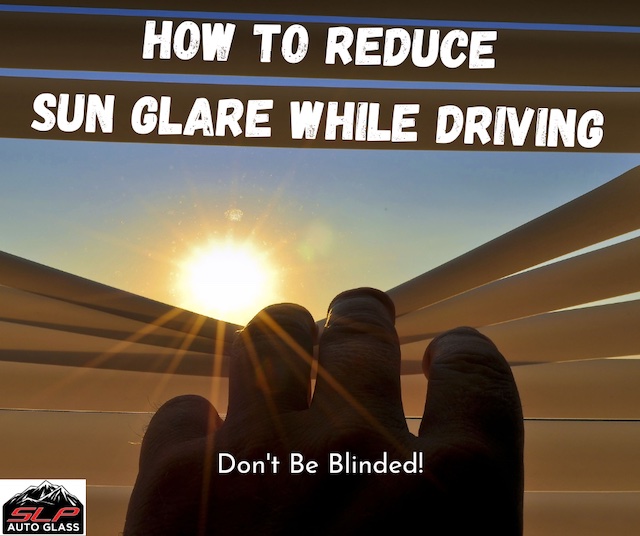At SLP Auto Glass, we often discuss the dangers of cracks and chips obstructing your driving vision. It feels routine at this point to discuss the dangers of driving with a view that’s less than optimal, for it’s one of the main selling points of our services as a windshield repair company. Simply put: you should never drive without having a clear and precise view of the world around you. We often forget the other dangers that can skew your driving vision, like sun glare.
As a recent Denver transplant (go figure), I must note the extreme intensity of the Colorado sun. Back east, the setting sun was a minor inconvenience, causing you to put on your sunglasses for a few moments. In Colorado, the setting sun causes a downright dazzle, bullying the eyes of drivers and passengers alike. It’s not only difficult, but it’s significantly dangerous. Pick the perfect time of day, and you will not be able to see the lines of the road and the cars around you. No fun.
But is there a way to reduce sun glare while driving? How can you battle those rush-hour rays, blinding all that dares to look at them?
Winter Is the Worst
Already disliked winter enough with its brutal cold and slippery ice? Well, we’re here with some rather unfortunate news. If you have trouble with sun glare during your commute, it will only get more severe during the winter months. Shocking.
To put it lightly for those of us that aren’t astronomers, it has to do with the position of the earth during the frigid months. During the summer, the sun takes a path (realistically, the earth takes the path. Right, Galileo?) at a less drastic angle, causing it to look as if it passes through the sky straight up. During the winter, that angle is lower. Therefore, the sun goes across the sky closer to the horizon. This angle gives us more exposure to ultraviolet rays and glare.
It’s also important to note the presence of snow. When snow is present, it can reflect rays directly upward, causing glare to be remarkably more drastic. White snow and bright sun rays are a bad combination for the eyes.
Sun glare can be so bad in Colorado that they have to close parts of highways.
What Times Are Worse?
If you are lucky enough, you may be able to plan your commute around the blistering rays. It truly depends on the time of year. though.
As a rough estimate, you can expect the sun to be the worst right around high-traffic times. How ironic! The sun is usually the most imposing from sunrise to 8 am and from 5 pm to sunset.
If there is a covering of snow or summery haze in the air, it would be best to avoid driving during these times. Of course, with the average job going from 9-5, it’s close to impossible.
Can You Reduce It?
Ultimately, it can be hard to fight against nature. Are there actual scientifically significant ways to battle the vision-impairing sun? Not really. It’s impossible to stop something so impeding and intimidating as the great glowing sun. There are ways to help improve your vision, though.
At the end of the day, this will require trial and error. Some tips may work better than others depending on your eyesight, car build, and driving direction. Obviously, if you are heading west during sunset or east during sunrise, you can expect things to be worse than the versa.
1. Polarized Sunglasses
Let’s get the obvious one out of the way. Sunglasses are made to block the sun. Whoa!
Sunglasses should be used in conjunction with any of the following tips on this list. There’s no reason to not have sunglasses covering your pupils during sunny drives. If you are a glasses wearer and need sunglasses with your vision prescription, it may be a worthy investment. Paying for car damages may be way more expensive than new and effective sunglasses.
While all sunglasses may be stylish or comfortable to someone, not all are great at doing their namesake. If you are planning on getting sunglasses for sunny drives, aim for polarized lenses. These lenses have a special chemical laminated on them vertically. This vertical adjustment helps reduce glare and reorganize light, blocking it vertically like a chemical window blind.
2. Clean Your Windshield
Oh boy. Don’t get us started on how important a clean windshield is.
Dirt, oil, soap residue, dried-on washer fluid, and general debris that has been caked on your windshield can be wonderful reflectors of light. When the sun strikes these unsavory cakes, glare can (and likely will) shoot right into your cabin, causing impaired vision. Therefore, a dirty windshield can make sun glare issues dramatically worse.
You should always keep your windshield clear, especially if you are having vision problems. Not only will it cause sun glare problems, but it can cause basic vision issues. It’s that simple.
Clean it!
Bonus: Cracks and imperfections in your auto glass can cause sun rays to splinter, increasing glare. If you have any chips or dents, get them fixed immediately. But we’ve already spoken enough about that here.
Make Sure Your Windshield Wipers and Fluid Work
In correlation with dirt and debris increasing glare, your windshield wipers should be in working condition during sunny days. Make sure that your windshield wipers are of top quality and that your fluid is topped off. If you have any debris or dirt splash on your windshield, you will be able to use your windshield wipers and fluid to get it off before it increases the glare.
This is especially true for the winter. During the winter, there are a plethora of new contaminants that can muddy your windshield (i.e. salt, dirty snow, and sand).
3. Tinting Is Possible
Auto glass tint is polyethylene terephthalate (PET), a thermoplastic polymer resin often applied to vehicle glass to reduce sunlight and cause darkness. Long story short, it’s used to make your windshield and windows darker to outside viewers.
In theory, tinting your windshield would make a notable difference on the amount of sun glare that peeks through. Unfortunately, this isn’t entirely legal. If state law let people put any strength of tint on their windshields, many drivers would go so dark they wouldn’t be able to see.
In Colorado, registered vehicles have to allow the transition of 70% of light through their windshield. It also can only be on the top 4 inches of your vehicle. Therefore, you can tint your windshield but not enough to make a big difference in glare.
If you have extreme trouble with sun glare, the 4 inches may still be worth that. Tint, in conjunction with sunglasses and a sun visor, can help dramatically.
4. Infrared Windshields?
Ever heard of infrared or solar windshields? See their claims of being able to block all harmful UV rays from the inside of your vehicle? Think they may be able to stop the pesky sun glare?
Solar windshields are the same makeup as normal windshields but involve a metallic (often silver alloy) glaze placed upon the outside pane. This invisible-yet-complex coating works to reflect a majority of infrared rays, while still allowing light rays to get through. Therefore, the driver’s vision is not affected despite a reduction of rays entering the vehicle. Less infrared means less heat, not less glare.
Unfortunately, the process does not involve a thorough blocking of rays. The glass works to reflect around 50% of IR light. Blocking out the entirety of IR rays would mean blocking out visible light, too. IR light isn’t the rays that cause sun glare. So, the specialized windshields only work to reduce heat inside of the vehicle, not light.
Get Your Glass Repaired!
If a dirty and damaged windshield increases the potency of sun glare, then you should get your glass fixed ASAP. Furthermore, a damaged windshield affects your overall vision. No good.
Time for self-promotion!
At SLP Auto Glass, we are committed to excellence in everything we do. We are passionate about ensuring that your vehicle is in a much safer state with a new windshield designed and installed with safety in mind.
As a full-service and locally-owned auto glass company, we care about our friends and neighbors. You can count on us for fast, efficient, reliable and affordable auto glass services that are customized to meet and exceed your needs.
Reach out to us! We can give you a free quote ASAP. Let’s reduce that glare!
Content reviewed and published by SLP AutoGlass Editorial Team.

